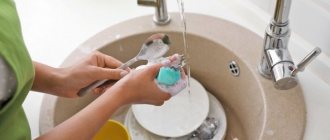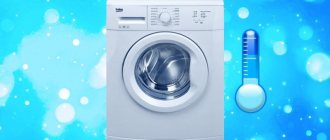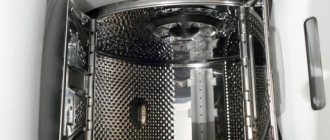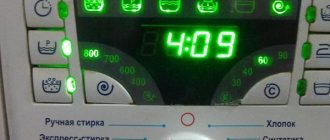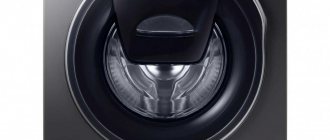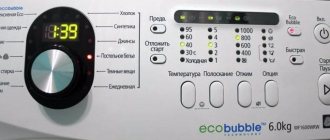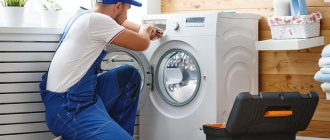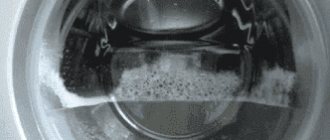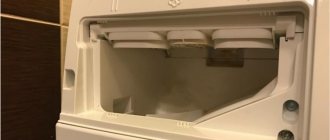The water consumption of a washing machine is one of the technical indicators that affects the efficiency of washing and the efficiency of equipment. According to experts, the device wastes up to 25% of the total volume of cold water consumed by a family of 3 people. The level of water consumption depends on the degree of loading of the drum, the technical condition of the machine and the selected washing and rinsing modes.
What affects consumption?
What determines the water consumption of a washing machine:
- brand and manufacturing company;
- washing program, type of fabric and heating;
- loading the tank;
- use of additional functionality;
- tank size.
Comment! Most brands offer a choice of different wash cycles. They are equipped with a whole range of operations, differ in the duration of programs and the consumption of electricity and water.
| Normal wash program (without additional functions) | Loading | Water flow parameters | Duration |
| Colored things 400 C | 4.5 kg | 49 l | 115 min. |
| Colored things 600 C | 4.5 kg | 49 l | 115 min. |
| Colored items 600 C, intensive wash/stain removal | 4.5 kg | 49 l | 135 min. |
| White laundry 900 C (hot detergent solution is mixed with 7 liters of hot water before draining) | 4.5 kg | 56 l | 120 min. |
| Synthetic 400 C | 2.0 kg | 48 l | 75 min. |
| Delicates 300 C | 2.0 kg | 55 l | 45 min. |
| Wool 300 C | 2.0 kg | 35 l | 55 min. |
The following programs demonstrate minimal consumption of water resources:
| Mode | Peculiarities |
| Fast | Linen is washed at low heat, up to 300 C for 15-40 minutes. Suitable for things that do not have difficult stains, as it is not intense. |
| Manual | Fast mode with work stops. |
| Daily | Used for fabrics made from artificial fibers. Duration does not exceed 40 minutes. Allows you to clean only those fabrics that can be washed easily. |
| Delicate | Processing time is about half an hour. Designed for delicate fabrics. |
| Economical | Not all washing machines have the program. Its task is to save water and electricity. At the same time, the process takes a long time, which helps to clean things well. |
The operation of some programs and functions leads to increased water consumption and increased amounts in utility bills.
| Washing program | Characteristics |
| Cotton | Long-term processing of laundry when heated to 600 C or more. |
| Baby clothes | Provides a large number of long rinses, which significantly increases the volume of water consumed. |
| Taking care of your health | Active rinsing mode. Wastes a large amount of resources. |
Important! A large tank volume in a washing machine is the most important sign that it will consume a lot of cubic meters.
| Name | Front loading washing machine | |||||
| Capacity | 4 kg | 5 kg | 5.5 kg | 6-6.5 kg | 7 kg | 8 kg |
| Power supply | 220-240 V, 50 Hz | |||||
| Size (WxDxH) | 600x360x850 mm | 600x440x850 mm | 600x550x850 mm | |||
| Water consumption | 39 l | 48 l | 52 l | 56 l | 49 l | 56 l |
| Energy efficiency class | Class A | |||||
Siemens WS 10G240 OE
Another “masterpiece” of German mechanical engineering is the Siemens WS series washing machine. A relatively inexpensive and economical model, consuming an average of 40 liters of water per wash cycle. By washing clothes using the “quick wash” program, you can further reduce water consumption to 37 liters.
Under normal conditions, unless there is a malfunction, any of the above machines, even with record low water consumption, washes clothes perfectly and the fact of saving water does not in any way affect the quality of the wash. It’s another matter if the user, in pursuit of savings, chooses unjustified washing modes for a certain type of laundry or loads more laundry into the drum than the maximum drum load indicators allow.
When preparing to wash your items, read the instructions that came with your washing machine. Act in strict accordance with the recommendations of the instructions, and then the quality of washing and water consumption of the washing machine will satisfy you. In order to solve the problem of excessive water consumption by a washing machine, you first need to identify it.
In other words, you need to find out whether your machine really spends too much water or if it just seems so to you. What should be done?
- Take a look at the passport of your washing machine and see how much water your machine should draw and consume in 1 wash cycle.
- Select the most economical washing program that your machine has in its “arsenal” (usually “quick wash”, “accelerated wash”, “quick 30”, etc.) and record the volume of water consumed using the water meter.
- Select the most water-intensive washing program (usually programs associated with washing cotton or bulky items) and also track how much water was used using the water meter.
- Based on the resulting indicators, calculate how much water your washing machine uses on average.
Note! When you measure the water consumption of the washing machine, do not forget to turn off all the taps in the house, as well as the toilet tank, for the duration of the wash, otherwise the calculations will be incorrect. If, as a result of the measurements and calculations, you received a value close to what the manufacturer indicates in the passport (+- 15 liters), this is normal
This means that everything is fine with your washing machine and there is no need to take any measures. But if the actual water consumption is much higher, say 30 or even 50 liters more than the value declared by the manufacturer, urgent measures need to be taken. If you do not violate the instructions for using the washing machine, most likely there is a malfunction and you need to contact a specialist
If, as a result of the measurements and calculations, you received a value close to what the manufacturer indicates in the passport (+- 15 liters), this is normal. This means that everything is fine with your washing machine and there is no need to take any measures. But if the actual water consumption is much higher, say 30 or even 50 liters more than the value declared by the manufacturer, urgent measures need to be taken. If you do not violate the instructions for using the washing machine, most likely there is a malfunction and you need to contact a specialist.
For our part, we advise you not to climb into the car body yourself. Troubleshooting on your own may well be fatal for your washing machine. It is better not to skimp on a specialist, but later save on water when the machine malfunction is professionally repaired. If you decide to find and correct the defect yourself, read about how to properly disassemble a washing machine.
To summarize, we note that everyone who uses an automatic washing machine needs to know how much water it consumes. This is necessary not only to save on utility bills. Increased water consumption is an indirect sign of a serious malfunction that can lead to the failure of the home assistant.
When the owners of their household appliances find out how much water an automatic washing machine consumes in one wash, an emergency economic council is convened in the house. The agenda is how to avoid excess fluid consumption.
How can I find out the exact data?
When purchasing household appliances, the buyer receives a technical passport. The manufacturer is obliged to indicate the characteristics of the product in it. For washing machines, one of the points necessarily concerns average water consumption.
Advice! If the actual water consumption significantly exceeds the figures given in the technical passport, this is a reason to contact a specialist to diagnose the equipment for a malfunction.
Breakdowns often lead to overuse of resources:
- fill valve;
- water level sensor;
- relay;
- water flow regulator.
To control the water supply in the washing machine yourself, you can focus on the average consumption when loading 2-3 kg of laundry into the tank:
| Operation | Consumption |
| Wash | 12 l |
| I rinse | 12 l |
| II rinse | 15 l |
| III rinse | 15 l |
Which devices consume the most electricity - comparison
There are many factors that influence the average electricity consumption of a single-family home or apartment, and the percentage contribution of individual devices to energy bills is as follows:
- 30% of energy is consumed by the refrigerator,
- 21% of energy is consumed by lighting.
- 20% of electricity is consumed by an electric stove,
- 10% of the energy is consumed by the washing machine,
- 6% of energy is consumed by the TV,
- 5% of energy is consumed by an electric kettle,
- 3% of energy is consumed by the computer,
- The rest of the electricity bill is generated by other electronic devices such as the radio, dishwasher and so on.
Consumption depending on model
Companies that produce washing machines independently determine how much water the tank should be filled with.
Comment! The more modern the model, the more efficient its operating mode is and the more efficiently resources are spent. Some manufacturers equip their equipment with a laundry weighing function.
| Brand of household appliances | Average volumes of water consumed | Characteristics of models and washing programs |
| LG | From 7.5 to 56 liters, depending on the filling level of the tank, LG equipment has eight of them. | Washing modes are calculated based on the types of fabrics; each of them absorbs water differently. The recommended tank load can be 2, 3 or 5 kg, so that the machine is filled to a low, medium or high level. |
| INDESIT | From 42 to 52 liters per 5 kg of laundry | Water consumption depends on the program. Washing options are clearly indicated on the body of the washing machine. All modes are numbered and divided by tissue type. Most models have an Eco Time function that saves resources. |
| SAMSUNG | From 39 to 50 l | The brand produces equipment with great water savings. But consumers note that it is necessary to choose the right model. Thus, a machine with a depth of 35 cm can become unprofitable for a family of 4 people, since it will have to be started more times. |
| BOSCH | From 40 to 50 liters per 5 kg of laundry | Modern models have a significant advantage: thanks to the automatic laundry weighing function, they can reduce water consumption. |
Some top-loading washing machine models from various brands can consume several times more resources than side-loading appliances.
How much H2O is lost in one wash?
Water consumption directly depends on the capacity of the device.
Regular (narrow, full-size)
These are middle-class machines, where a narrow one can wash 9 sets of dishes in 1 cycle, and a full-size one can wash 10-14.
The average consumption for such equipment ranges from 9 to 14 liters. In this case, we are talking about cold water, since PMMs are often connected to cold water supply in order to save resources. That is, to wash 9 sets of dishes, the machine needs only 9 liters of water - this is quite economical.
The peculiarity is how this technique works. The PMM collects water once and uses it to wash dishes. In this case, the water passes through the cleaning filter during the cycle. Towards the end of the procedure, the technician again takes water to rinse the dishes and completes the cycle with a final rinse.
The cost-effectiveness of popular PMMs priced up to 40,000 rubles is presented in the table:
Economical
Dishwashers are produced that spend only 7 liters per cycle. Usually these are premium segment models or compact PMMs. Low water consumption does not always mean low capacity of equipment.
There are models with a large load but minimal consumption, but they are expensive. Example - Siemens SN 236100 ME, whose water consumption is 6.5 liters.
This is a full-size appliance, designed for 13 sets of dishes, with an energy consumption class of A++. As a rule, economical models require 40% less water than conventional ones.
Compact PMMs with a small capacity, designed for 6 to 8 sets of dishes, are also called economical. They consume the same amount of water as the narrow versions - 6.5 - 9 liters. It turns out that their level of water consumption is similar to large dishwashers, but they are capable of washing much less dishes.
Comparison with hand washing
When washing by hand, in order to wash the amount of dishes that would fit in the PMM, you will need 70 - 100 liters of water, both hot and cold.
That is, a machine with a flow rate of 7 - 14 liters requires 10 times less water.
Approximate calculation:
- Dishwasher. 14 l x 360 (days) = 5040 l (cold water);
- hand wash. 70 l x 360 = 25200 l (12000 – cold, 13200 – hot).
The price of 1 cubic meter of water depends on the region of residence. For example, a cold one costs 30 rubles, a hot one – 100.
It turns out:
- PMM. 5040 x 30 = 151.2 rubles;
- manual. 12 x 30 + 13.2 x 100 = 1680 rubles.
If you take into account water consumption, then a dishwasher is much more economical than washing by hand
Maximum and minimum flow
The technical data sheet of any washing machine contains test results .
They are carried out in laboratory conditions, with various loads on household appliances.
Testing allows you to set minimum and maximum water flow rates. The smallest volume is 38 liters, the largest is 80 liters.
Based on these data, it is possible to calculate the average amount of water resources consumed. It is equal to 59 liters. Many manufacturers cite these numbers in their documents.
You can check their . To do this you need:
- Record the readings of the meter that is connected to the cold water pipe.
- Turn on the machine on the longest mode.
- Check the meter again by calculating the cold water consumption. The resulting figure is the maximum water consumption of the washing machine.
- Wash the clothes again on the fastest cycle.
- Note the counter indicator. This is the minimum cost.
- Calculate the average value and compare it with the numbers given in the washing machine data sheet.
Conclusion! The coincidence of actual consumption with the data in the passport, as well as a discrepancy of 15 liters or less are considered normal.
Energy consumption classes (energy efficiency)
The energy efficiency class determines the amount of energy that the device uses. The higher it is, the more effective the costs are. This parameter is considered one of the main indicators of the quality of the device. On average, the power of a washing machine can reach 4 kW. Today, many are trying to save resources, so they tend to use household appliances that belong to class A or B.
The presence of the letters F or G characterizes the quality of energy saving as poor and very poor, D and E – normal and satisfactory. Before assigning an energy saving class for parameters such as washing, spinning, and energy efficiency, a comparison is made with the standard. They have a special installation with constant performance indicators. The technique under study is compared with it.
Energy efficiency class table
| Class | Power consumption, kW/h per 1 kg of laundry | Energy efficiency index, % |
| A, A+, A++, A+++ | 0.13-0.17 | 30-55% |
| IN | 0.17-0.19 | 55-75% |
| WITH | 0.23-0.27 | 75-90% |
| D | 0.27-0.31 | 90-100% |
| E | 0.31-0.35 | 100-110% |
| F | 0.35-0.39 | 110-125% |
| G | more than 0.39 | from 125% |
Nowadays it’s difficult to find a washing machine with a class below B on sale.
Another energy consumption criterion is programmable mode optimization. The less time the machine takes to wash, the less electricity is consumed. For example, a device with energy efficiency C washes very dirty clothes in 2 hours 40 minutes, and a more economical unit of class A washes them in 2 hours.
Just 10 years ago, manufacturers produced equipment only with efficiency A; today, thanks to the latest technologies, there are devices of class A+, A++ and A+++. They consume less electricity by 10, 30 and 50%, respectively. The service life of budget models is at least 5 years, more energy efficient - from 15 to 20 years. During this time, it is possible to save a large amount of electricity.
How to save money?
To reduce resource consumption and your own financial costs for utility bills, you can take advantage of the following savings opportunities :
- completely fill the tank with laundry;
- do not use the pre-soak option if there are no difficult-to-remove stains on the clothes;
- use high-quality laundry detergents to prevent repeated treatments;
- use only powders intended for washing machines; they create a small amount of foam and rinse out faster;
- give preference to the quick wash mode.
Standards
The average water consumption is indicated by the manufacturer in the washing machine data sheet. If you compare different products from different manufacturers, the indicator will be different, but some average figures can be derived. How much water does a washing machine use per wash?
According to data published by experts, the volume spent in 1 washing cycle ranges from 38 to 80 liters. Using simple calculations, you can calculate that the average water consumption per wash is 59 liters.
Important! If an automatic machine uses more water, it means either the equipment is faulty or you are choosing too water-intensive modes. In any case, you need to pay attention to this, as well as to.
Water supply
The most convenient in this regard is an automatic car.
. Only cold water is supplied through the water supply system, but it is heated inside. This is very convenient if hot water is often turned off in your home.
Now semi-automatic
They are mainly connected to the water supply, but require connection to both cold and hot water. There are also semi-automatic models that you need to fill with water yourself, but they are now considered obsolete.
Ultrasonic
The washing machine is not stationary, so it requires a container of water at the temperature required for the laundry. You should collect water yourself in any way convenient for you.
